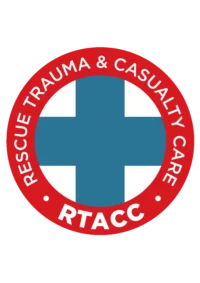Who Should Attend?
RTACC is an intermediate to advanced level course in TAG’s Integrated Emergency Care Programme (IECP) which progresses candidates from first aid through to critical care interventions. IECP is a progressive and systematic pathway to enhancing skills, knowledge and empowering people to save lives.
ACCREDITATION BODY
RTACC is an advanced prehospital care provider level focused trauma and casualty care course, it can be adapted and delivered with the specific needs of organisation in mind. Candidates will be exposed to real life scenarios environments which are greatly enhanced by live actors and simulation.
RTACC has been developed by leading pre-hospital doctors and healthcare professionals and immerses the learner in their own working environment, delivering interventions and knowledge to assess, treat and prioritise a wide range of time critical and life changing features of trauma thus ensuring better outcomes and excellent casualty care.
What are the objectives of RTACC?
The objective of the qualification is to benefit learners by preparing them to deal with the most serious medical and trauma in a realistic and immersive way that develops skills and confidence. It is designed to support Emergency Services workers, Close Protection Operatives and Emergency Responders to respond to medical emergencies in the context of their role.
Who can take part in RTACC?
To undertake this course, you must be at least 17 years old.
Due to the language of the assessment, it is recommended that learners have sufficient command of the English language in order to understand the assessment and to undertake the recommended assessment methods.
Candidates must have an understanding of basic First Aid and ideally have attended a 1 day First Aid Trauma and Casualty Care (FTACC) or Emergency First Aid at Work within the last 3 years.
Due to the nature of this qualification, candidates should be physically capable of undertaking practical assessments in a range of environments. There are no other pre-requisites for this qualification; however, learners should be able to work at level 2 and above.
Why should I enrol on this course?
The purpose of this qualification is to develop learner’s knowledge and skills in casualty care (enhanced First Aid) relevant to a particular specialisation (responding to medical emergencies) within an occupation e.g. Emergency Services, Close Protection Operatives and industrial Emergency Response teams.
This qualification demonstrates to employers and education establishments a learner’s ability to develop their skills and knowledge in technical and non-technical skills and casualty care. It would strengthen a university application to study a healthcare related subject such as medicine, paramedic science and nursing.
Is RTACC accredited?
The RTACC course is accredited and recognised by Royal College of Surgeons of England (RCS England). The RTACC course is clinically underwritten by suitably qualified Critical Care Doctors and Prehospital Care Clinicians provided by The ATACC Group and the wider ATACC Faculty and backed by the expert Medical Advisory Group.
We are also able to offer a regulated RTACC qualification that sits on the regulated qualification framework (RQF). This has been developed in collaboration with Qualifications Network UK (QNUK), who are a Awarding Organisation (AO) regulated by Ofqual, Qualifications Wales and CCEA Regulation in Northern Ireland.
What is the trainer to learner ratio?
The maximum Trainer to learner ratio for this qualification is 1:6. The course is designed for a maximum of 12 students (2 Trainers to 12 students).
How is the RTACC assessed?
To successfully complete the course, each candidate is required to pass a summative theory multiple-choice-question paper and a series of skill stations and scenario-based practical assessments.
Why does RTACC use live actors?
The course is designed to be delivered through high fidelity simulation and training in a unique and motivational style that is easy to follow and understand. We have been involved in emergency care training for 20 years and feel it is important to truly immerse candidates into a scenario. Using live actors helps bring a scenario to life and applies pressure to partly replicate the reality of dealing with critically injured casualties.
Does RTACC map to the Pre-Hospital Emergency Medical (PHEM) Competency Descriptors and Framework?
Yes, RTACC has been mapped at Level E on the PHEM framework. It also exceeds the First Aid at Work (FAW) HSE syllabus and covers catastrophic bleeding as standard. Both BTACC and RTACC cover additional knowledge and skills above traditional workplace requirements.
Upcoming 'RTACC "Rescue Trauma & Casualty Care" Courses
December 2025
Paediatric First Aid (PFA)
First Aid at Work (FAW)
Paediatric First Aid (PFA)
First Aid at Work – Requalification (REQ)
Emergency First Aid at Work (EFAW)
January 2026
First Aid at Work (FAW)
First Aid at Work – Requalification (REQ)
Paediatric First Aid (PFA)
Emergency First Aid at Work (EFAW)
February 2026
Emergency First Aid at Work (EFAW)
First Aid at Work (FAW)
First Aid at Work – Requalification (REQ)
We can also deliver this training course, anywhere in the country, or in our training facility. Please contact us to discuss your specific training needs.

